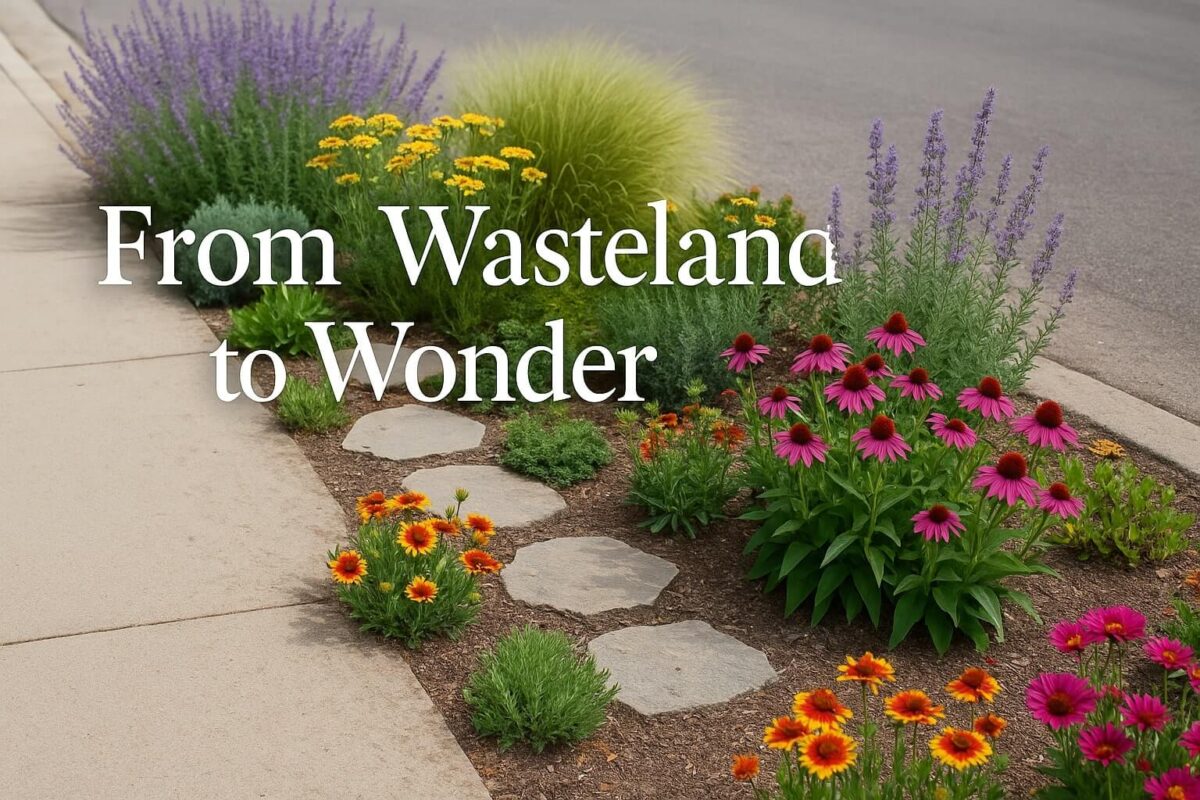Every neighbourhood has them. That tired, narrow stretch of dirt or patchy grass wedged between the sidewalk and the street. It’s too skinny for trees, too sunbaked for grass, and too overlooked to feel like it matters. Yet this gritty little patch, often dubbed the “hellstrip,” holds more potential than most people realise. With a bit of care, the right plants, and some clever design, these neglected slivers can become ecological powerhouses, curb appeal boosters, and tiny pockets of joy.
Welcome to the world of hellstrips, where resilience meets beauty at the edge of the pavement.
Why hellstrips are hard but worth it
It’s not just a catchy name. Hellstrips are challenging. They endure the worst conditions a garden can face. Compacted soil from foot traffic, salty splashback from winter roads, reflected heat from asphalt, and the occasional bike tire or car door. Some strips barely measure two feet wide. Others are crisscrossed by utility lines or tree roots. It’s no wonder they often get ignored.
But here’s the twist. Precisely because they’re tough, hellstrips invite creativity. They ask us to look closer, to choose hardier plants, to use water more wisely, and to think about beauty in unexpected places. When done well, these tiny gardens can become havens for pollinators, sponges for rainwater, and delightful visual cues that soften the boundary between public and private space.
First steps before planting
Before you grab a shovel or head to the nursery, check the rules in your city. In many areas, the strip belongs to the municipality, but homeowners are responsible for maintaining it. That means there might be height limits for plants, or rules about visibility and access. Some cities, like Seattle, even offer permits and plant lists to encourage residents to garden their hellstrips safely.
Once you know what’s allowed, give the soil a closer look. Most hellstrips have been compacted for years. Start by loosening the soil to at least 8 inches, then mix in compost to give roots a fighting chance. Topping with gravel mulch can reduce evaporation, suppress weeds, and help the space look clean even before your plants fill in.
Design-wise, think practical first. If people park along the curb, add stepping stones so passengers don’t crush your plants getting out. If drainage is poor, consider carving a shallow dip or swale to catch stormwater. Where allowed, a curb cut can let gutter runoff filter naturally through the soil instead of running into drains.
Plants that shine in tough spots
Now for the fun part. Choosing plants for hellstrips is about more than just toughness. It’s about finding charm in resilience.
-
Groundcovers like woolly thyme, blue grama grass, or ajuga form dense mats that smother weeds and tolerate heat. Many are fragrant and soft underfoot.
-
Perennials such as Russian sage, yarrow, blanket flower, and coneflower bring colour, long bloom periods, and drought resistance.
-
Grasses like little bluestem and Mexican feather grass add movement, texture, and winter interest while anchoring the soil.
-
Native plants like milkweed, prairie winecups, and penstemon support pollinators and need minimal care once established.
Stick to a palette of three to five plants, repeating them in drifts to avoid chaos. If you want year-round appeal, combine flowering perennials with evergreen groundcovers or dwarf shrubs under three feet tall.
Even better, choose plants native to your region. They’re more likely to thrive in local conditions, feed local insects, and survive without extra fuss.
Tips for a low-maintenance transformation
The first year is the most important. Water deeply once a week while roots are establishing, then let rainfall take over unless your climate is especially dry. Remove weeds quickly before they spread. Replenish mulch every year or two. And don’t forget to trim spent stems in early spring, leaving enough behind to shelter overwintering bugs.
Try not to overplant or go too tall. Keep sightlines open for drivers and pedestrians. A well-tended hellstrip is about harmony, not jungle vibes. The goal is something that feels intentional, cared for, and welcoming.
Gravel paths or edging can also help define the space. This isn’t about hiding the strip, it’s about celebrating it, and showing others what’s possible even in a few square feet of soil.
Big impact from a small space
What seems like an insignificant slice of sidewalk can become something meaningful. A hellstrip garden invites conversation. It slows people down. It offers colour, movement, and life in places we normally rush past.
It also has bigger effects. Hellstrips can filter rainwater before it enters storm drains. They offer pollen for bees and shelter for beneficial bugs. In some neighbourhoods, beautifully planted strips have even helped raise property values or brought communities together around shared planting days.
Most of all, they change our relationship with the land we walk past daily. When we transform a hellstrip, we’re sending a message: every space counts, no matter how small or difficult.
So the next time you glance at that scruffy patch near your curb, imagine what it could be. Not a no-man’s-land, but a narrow ribbon of possibility. A mini-meadow, a pollinator buffet, or simply a place to grow something beautiful. The hellstrip may have an uninviting name, but with a little vision, it can become one of the most rewarding spots in your whole garden.

